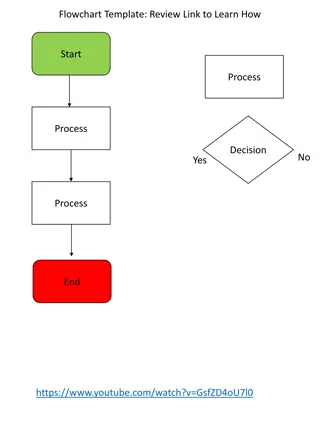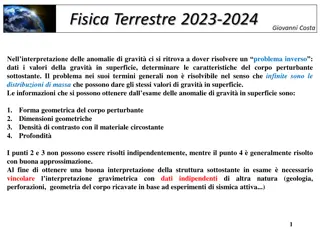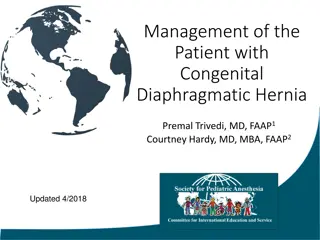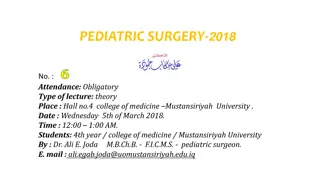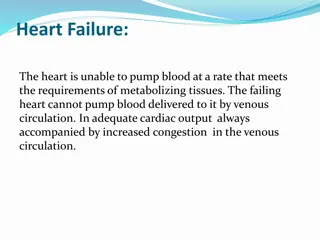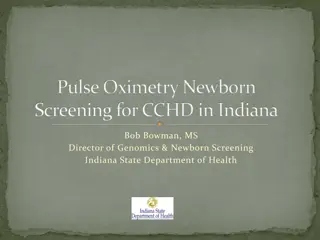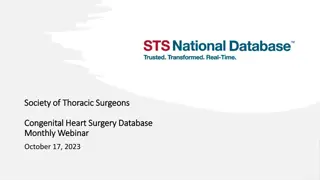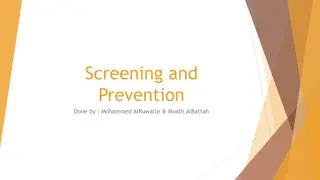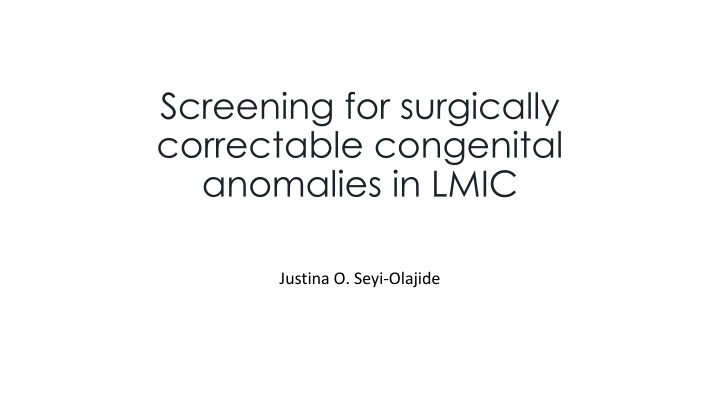
Screening for Surgically Correctable Congenital Anomalies in Low- and Middle-Income Countries
Discover the importance of early identification of surgically correctable congenital anomalies to reduce morbidity and mortality in children in low- and middle-income countries. Explore feasible screening methods, including prenatal and neonatal approaches, to improve outcomes and optimize resources.
Download Presentation

Please find below an Image/Link to download the presentation.
The content on the website is provided AS IS for your information and personal use only. It may not be sold, licensed, or shared on other websites without obtaining consent from the author. If you encounter any issues during the download, it is possible that the publisher has removed the file from their server.
You are allowed to download the files provided on this website for personal or commercial use, subject to the condition that they are used lawfully. All files are the property of their respective owners.
The content on the website is provided AS IS for your information and personal use only. It may not be sold, licensed, or shared on other websites without obtaining consent from the author.
E N D
Presentation Transcript
Screening for surgically correctable congenital anomalies in LMIC Justina O. Seyi-Olajide
Introduction Surgically correctable congenital anomalies in LMIC Significant burden of morbidity and mortality in children Early identification Reduction in death and disability Aim of study Identification of feasible screening methods Prenatal and neonatal
Inclusion criteria and feasibility Articles from 2000 to May 25, 2020 Any language Prenatal and neonatal screening methods in LMIC Feasibility Suitability given available resources Monitoring capacity Acceptable outcomes
Results Type of study Prospective: 16 Cross-sectional: 6 Retrospective: 2 Number of screening methods One: 15 Two: 7 Three: 2
Results 9 screening methods 3 antenatal 6 postnatal
Types of anomalies
Results Antenatal Ultrasound scan Diagnosis of fetal anomalies Facilitates counselling and prenatal interventions Appropriate postnatal management Decreased morbidity and mortality Low detection rate Insufficient number of scans Lack of expertise MRI: compliments USS Fetal Echocardiography: Cardiac anomaly
Results Age 1 hour to 59 days Frequently used Physician clinical examination Pulse oximetry Echocardiography Combined methods Clinical evaluation by trained midwives combined with photographs Clinical evaluation and pulse oximetry Echocardiography Confirmation
Results Feasible Physician clinical examination Clinical examination using pictures Clinical examination by non-physicians Ultrasound Somewhat feasible Fetal ultrasound Pulse oximetry
Discussion Screening programs in LMIC Missing or only recently developed Challenges in LMIC Highest number of birth defects Limited resources Lack of training Lack of sustainability
Discussion Inexpensive methods exist and are available Combining methods Increase recognition and diagnosis Reduce delays in management No systematic programs
Recommendations Fetal ultrasound scan as integral part of primary health care Incorporating TBAs for out of hospital births Training surveillance officers Population based screening programs Clinical examination with photographs Pulse oximetry Prenatal ultrasound scan
Limitations Limited to LLMICs Limited number of countries Limited specialties Heterogeneity of articles Low quality of some articles
Conclusion Screening for surgically correctable congenital anomalies Feasible Need for a reliable tool Development of screening protocol Seyi-Olajide JO, Ma X, Guadagno E, Ademuyiwa A, Poenaru D. Screening methods for congenital anomalies in low and lower-middle income countries: A systematic review. J Pediatr Surg. 2023 May;58(5):986-993. doi: 10.1016/j.jpedsurg.2023.01.038. Epub 2023 Jan 25. PMID: 36822972.

